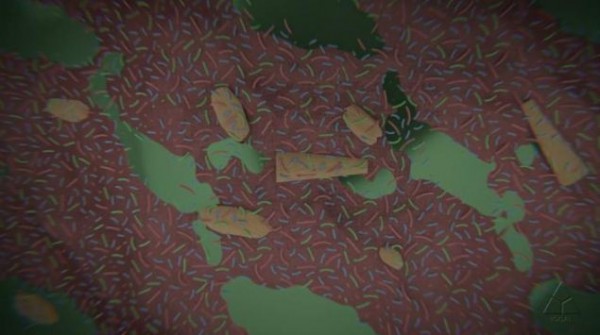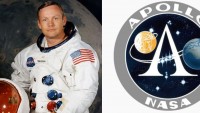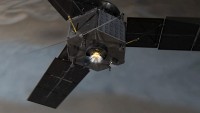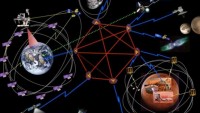NASA Study Delves Deeper into the Human ‘Microbiome’ and ‘Omics’
| Arthur Dominic Villasanta | | Jul 29, 2016 08:28 AM EDT |
(Photo : NASA) llustration of microbes in a human which make up the microbiome.
NASA's Human Research Program (HRP) has released another video to highlight microbial research on the International Space Station (ISS).
The video, "Microbiomics: The Living World In and On You" focuses on the "Twins Study," of Scott and Mark Kelly's microbiome (the collection of each individual's microbes) using "omics."
Like Us on Facebook
It explains the significance of studying the microbiome and provides a glimpse into the evolving field of omics and the research HRP is conducting via its Twins Study. This video is the seventh in the eight omics video miniseries. It focuses on the importance of the microbiome and provides a broad overview of ongoing Twins Study research.
Omics is an evolving field integrating collections of measurements, biomolecules and sub-disciplines to provide a more complete picture of health. It includes studies of DNA, RNA, proteins, environment and metabolites, in addition to the microbiome.
NASA is studying the microbiomes of Mark and Scott Kelly to explore the identical twin brothers' dietary differences along with the space environment to determine how both affect the organisms in their guts.
"In this research, we're sequencing bacteria for this study using two different methods to obtain the most accurate data," said NASA Twins Study Principal Investigator Fred Turek, Ph.D., Northwestern University, Feinberg School of Medicine, Center for Sleep & Circadian Biology.
"Your microbiome is like the ecology in the rainforest where the species depend on each other. What happens when a species is removed? Does another out-compete and take over? We're really looking to see if different families, genes or species of bacteria have increased, decreased or even exploded or disappeared in Scott Kelly during his time on the space station."
Turek said it's an exciting time in the microbiome research world. Advances in technology have opened up a whole new world for medical researchers.
NASA microbiologist Sarah Wallace, Ph.D. said NASA is testing a new, smaller, portable DNA sequencer for spaceflight. This instrument generates a DNA sequence in a fundamentally different way from the larger sequencers. It detects bases as they pass through very small, nanometer-size, biological nanopore proteins.
"If an astronaut were to get an infection in deep space, the portable sequencer has the ability to help identify what exactly is causing the infection. In the past, tools on the space station required researchers to know specifically what to look for," said Wallace.
"The portable sequencer's identification of the infection is a significant advancement for spaceflight research."
NASA astronaut and molecular biologist Kate Rubins, Ph.D., will sequence DNA from a bacterium, virus and mouse in space for the first time, to confirm that the technique works correctly in space.
"We can extract DNA from the genome of a bacteria, sequence it and investigate the microbial world around us in space with less gravity, increased radiation and recycled air and water," she noted.
"The information we learn from these experiments using this technology can give us a better understanding of how it will work in remote research and medical environments, like the field laboratory where I used to work in Central Africa."
Brian D. Piening, Ph.D., who works in genetics at Stanford University School of Medicine and supports NASA's Twins Study, said researchers still need to ask the basic question of what happens to the human microbiome when placed in a unique environmental condition as space.
He said the NASA Twins Study should provide insight into how it changes along with whether this affects millions of other parameters in the human body such as biomolecules in the blood, changes to cognition, sleep and other factors.
Tagsmicrobiome, Microbiomics, NASA, Human Research Program, Twins Study, Mark and Scott Kelly
©2015 Chinatopix All rights reserved. Do not reproduce without permission
EDITOR'S PICKS
-

Did the Trump administration just announce plans for a trade war with ‘hostile’ China and Russia?
-

US Senate passes Taiwan travel bill slammed by China
-

As Yan Sihong’s family grieves, here are other Chinese students who went missing abroad. Some have never been found
-

Beijing blasts Western critics who ‘smear China’ with the term sharp power
-

China Envoy Seeks to Defuse Tensions With U.S. as a Trade War Brews
-

Singapore's Deputy PM Provides Bitcoin Vote of Confidence Amid China's Blanket Bans
-

China warns investors over risks in overseas virtual currency trading
-

Chinese government most trustworthy: survey
-

Kashima Antlers On Course For Back-To-Back Titles
MOST POPULAR
LATEST NEWS
Zhou Yongkang: China's Former Security Chief Sentenced to Life in Prison

China's former Chief of the Ministry of Public Security, Zhou Yongkang, has been given a life sentence after he was found guilty of abusing his office, bribery and deliberately ... Full Article
TRENDING STORY

China Pork Prices Expected to Stabilize As The Supplies Recover

Elephone P9000 Smartphone is now on Sale on Amazon India

There's a Big Chance Cliffhangers Won't Still Be Resolved When Grey's Anatomy Season 13 Returns

Supreme Court Ruled on Samsung vs Apple Dispute for Patent Infringement

Microsoft Surface Pro 5 Rumors and Release Date: What is the Latest?














